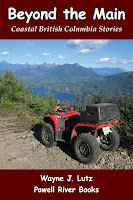“At Home in the Woods” by Vena and Bradford Angier
The book was written by Bradford and Vena Angier with Vena Angier as the narrator. The story was told from her point of view. I really enjoyed reading about their experience of moving off the grid to the Canadian wilderness.
 |
| The Peace River near Hudson's Hope in 1994. |
While living a simple life away from civilization they learned the skills needed to survive in the wilderness. They had minimal income from writing magazine articles, so they got as much of the food and materials they needed from the land.
 |
| Wayne in front of the Hudson Bay Post in 1994. |
The Hudson Bay Company Post in town was not only the trading post, but also a center for community life. People from around the area, including Vena and Brad, would go there for celebrations and events.
After three years, they left the bush and returned to the States. After a time back in civilization, they chose to return to Hudson’s Hope. And in the end, Brad was able to purchase the land on which their cabin stood. Now no one could take their dream away.
 |
| Arrow 997 with our tent at Hudson's Hope Airport in 1989 |
At Home in the Woods was re-released in 2015 (Down East Books) and is available from Amazon and other online booksellers in print and e-book versions. If you want to read a timeless off the grid adventure book, this is the one. -- Margy




















































